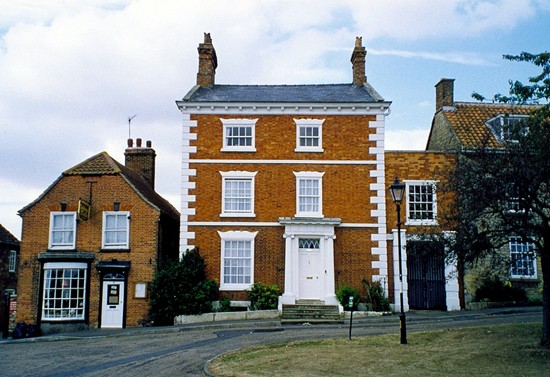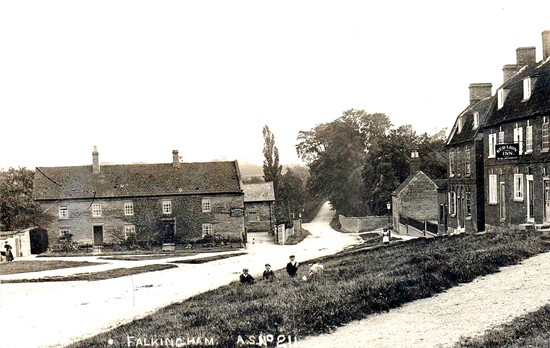|
Folkingham
Take the A15 north out of Bourne and you drive into unwrecked Lincolnshire. Folkingham is eight miles along the road where the undulating countryside eventually gives way to a magnificent view of the village on the far hillside and dominated by the tower of the historic church and the magnificent façade of the Greyhound, a coaching inn from the time of Queen
Anne built in mellowed red brick with stone string courses, window heads, sills
and corner stones. For over 1,000 years, this large village, or small town as it once was, became the meeting place of traders, farmers, huntsmen, robbers and pedlars. Before the Norman Conquest of 1066, Folkingham Manor had been the chief estate in this area of Ulf of Fenisc, a great landowner, but when the Normans arrived, the lands were handed over to Gilbert de Gant, a nephew of William the Conqueror's Queen Matilda.
Until the late 17th century, the present wide and attractive market place was by no means delightful because here were stacks of timber surrounded by a horse pond with a market cross and a dismal town hall, a butchery and a foul-smelling open well in front of the Greyhound Inn. The market place was also divided up with chains into areas for the sheep, cattle, horses and poultry, and for the sale of farm produce and other wares. But in 1788, the third Richard Wynne, who was then Lord of the Manor, was in financial difficulties and so he sold off the estate to Sir Gilbert Heathcote whose great-grandfather, the first baronet, was a Member of Parliament, Lord Mayor of London and Governor of the Bank of England. When Sir Gilbert took over, he did much to transform Folkingham into a charming small market town and his changes included clearing the market place of its various encumbrances and equipped it to cater for the stage coaches using the main London to Lincoln road which passed through. The Martinmas Fair on November 11th was ranked at one time among the most important in Lincolnshire but slowly declined and on Friday 25th November 1904, the Stamford Mercury gave the reason why: It has in recent years, fast fallen into decay. Some of the older residents can remember the time when as many as 2,000 head of cattle were exhibited but when the gathering was held on Tuesday, only one solitary beast was offered for sale. Many of the district farmers however, still attend. In a measure, its decline is attributable to a lack of railway accommodation, the town being three miles from the nearest station [at Billinborough]. There were numerous inns on this road catering for the coaches which stopped to change horses and soon the Greyhound was the most important in Lincolnshire. He also rejuvenated many of the town's other inns, including the Green Man, the Red Lion, the Five Bells, the Crown and the New Inn, but it was the Greyhound to which he paid the most attention and it was practically rebuilt in his enthusiasm to make it the perfect stopping place for stage coach visitors, spending £4,000, an enormous sum in those days, on giving it a new brick frontage and an arched stone entrance through which coaches would drive to the stables behind. The assembly room on the right was used as a courtroom for the Quarter Sessions, having stairs down to a prisoners' cell, and many distinguished travellers lodged here on their journeys and it soon earned a high reputation for its quality of food and service. The Greyhound was not used as an inn for many years during the late 20th century when the business failed and after standing empty for a period, it had a short revival with a refurbished ballroom, extensive catering facilities and an antiques and crafts centre. When this venture folded, the building again became vacant awaiting a buyer and in 2005 it was badly damaged by fire. The blaze broke out during the early hours of Saturday 9th April but firemen were quickly on the scene and managed to avert a major disaster. Nevertheless, ancient oak timbers were destroyed and part of the roof caved in before they brought the flames under control. The outbreak is believed to have been started by a squatter lighting a fire in one of the first floor rooms which then got out of control although the intruder has not been found. A green tarpaulin was used to cover the damaged section of roof and in August 2005 the inn was offered for sale at public auction and although 300 people turned up, it was withdrawn after failing to reach the guide price of £500,000. This was subsequently reduced to £400,000 and offered for sale by private treaty, possibly for use as a private home or for conversion into flats.
The Grade II listed property was eventually saved when it was purchased in 2006 by a Peterborough firm, Taylor Developments, for £300,000 and the company then announced plans to spend a further £1 million on turning it into a dozen one and two-bedroom luxury apartments. The new owners acknowledged the need for a sensitive conversion while preserving the exterior appearance and the many historic interior features. Work began in 2007 and was completed the following year, giving this historic building the new lease of life it enjoys today. The Greyhound still commands the pleasant and leisured air of past centuries while the spacious market square remains, surrounded by interesting buildings reflecting a mix of architectural styles, mostly well restored but not all sympathetically, while dominating the scene is a fine tall-towered mediaeval church.
St Andrew's Church was built between 1350 and 1530 and although its 15th century tower can be seen as you approach the village, it is tucked away in a lane off the market place. The tower has niches in its buttresses, a panelled doorway with roses and foliage and a lofty vaulted ceiling. The porch is also vaulted and over it is a room with a fireplace. Among the most noteworthy features is the 15th century elaborately carved wood chancel screen, once brightly painted but now a rich dark oak, its panels adorned with 12 saints, while a collection of local memorabilia, including the old village whipping post and stocks capable of holding three miscreants at one time, can be seen at the back of the church. In January 2007, the church was badly damaged during a violent storm and repairs have been estimated at £100,000. Shading the churchyard gate is a fine horse chestnut tree with a trunk that is about 14 feet round and a modern stone memorial commemorates the author Colin Watson, who died on 17th January 1983, aged 62.
The Lodge in the main street at Folkingham is a fine Georgian house of 1750 and was the home of Cuthbert Bradley (born 1861), artist and churchman who was churchwarden for 43 years while his wife was organist for 16 years. He was the son of the Rev Edward Bradley, vicar of nearby Lenton, and wrote a number of books under the name of Cuthbert Bede, particularly a humorous novel entitled The Adventures of Mr Verdant Green of which some 200,000 copies had been sold before his death in 1869. Cuthbert graduated from King's College in London and was destined to become an architect but childhood skills as an artist took over and he started to specialise in horses and hounds and hunting scenes which became the subjects of his paintings, caricatures and books while he rode regularly with the Belvoir Hack. In 1895, he married Lucy Heathcote, a descendant of Sir Gilbert Heathcote. The Bradleys lived at the Lodge for most of their married life and their son stayed on after their deaths. There was a Methodist chapel here for more than a hundred years, built in 1841 at a cost of £355 9s. 3d which included £60 for the purchase of the land covering 90 square yards. It was built of brick, pebble dash rendered with a clay pantile roof and inside there was a staircase to a gallery that had been added in 1845 at a cost of £63, the work of Thomas Pilkington, a Scotsman from Kelso, who had also built the chapel at Bourne. There was also an outside brick and tile store. A local carpenter and painter, Thomas Markland, a generous supporter of the Methodist cause, donated a stained glass window that was installed behind the pulpit. The Folkingham chapel was popular because a religious census of 1851 records that 38 adults were present at the morning service, 50 in the afternoon and 120 in the evening, but this popularity was not destined to last and by the turn of the century, rubbish was being dumped in the vicinity and the approach to the building was reported to be "in a most disgraceful condition". The chapel continued in use with declining popularity until 1975 when it was closed and the premises sold by auction on 29th June 1976 and the various furniture and fittings sold or given away.
The village school stands on the west side of the Market Place, built of red brick and blue slate during Victorian times, but now in private hands. It was erected in 1875 as the National School at a cost of £1,000 with room for 130 boys and girls and the average attendance in the early years was around 82. The school was supported by voluntary contributions, a government grant, an endowment from land at Pidley in Huntingdonshire (about £20 a year) and land at Pointon (£10 a year) which had been left in the will of Richard Brocklesby in 1713, and school fees at varying rates, 9d. for the children of tradesmen, 4d. for non-labourers and 3d.for labourers. It later became the village primary school, surviving into the late 20th century and eventually closing in 1976 under the re-organisation of education in the county. The building has since been sold and is now converted for use as offices for a home care company, ironically managed by Mr Darron Talton who was one of the last pupils to attend lessons there.
A sure sign that autumn has arrived in Folkingham is the vivid red of this Virginia creeper growing over an old pantiled cottage in the Market Place where it has been giving a colourful greeting to visitors driving into the village from the south and I took this picture in October 1999.
Wherever you walk in Folkingham, some of the sixteen pinnacles on the 15th century tower of St Andrew’s Church can be seen protruding above the skyline because the church stands on a hill and so it is in West Street. This narrow road contains a row of council houses built to provide homes for families in the population boom that followed the Second World War and here they have been designed in a crescent, rather like the Nash terraces built around England during Regency times, although for occupants of more modest means. These houses are known locally as the Wimpeys, an affectionate nickname that remembers the construction company that built them, and here we see them after the frontages have been given a new coat of white emulsion.
REVISED SEPTEMBER 2008 See also Storm damage to the church in 2007 Flooding in July 2007 Stow Green Fair John Byng's visit in 1791 Cuthbert Bede The House of Correction A Lincolnshire childhood
Go to: Main Index Villages Index |
||||||||||||||||||||||||||||||||||||||||


















